Listen! (Sound - Art - Music)
june 25, 2011.
It is (not) totally coincidental that this entry, after almost two months of 'no SB updates' ( * ), (not only) by its title is some sort of a sequel to the previous post, Hear it!.
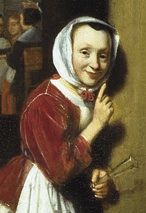 Listen. The other day in Belgium, in the Budascoop in Kortrijk (on Friday
May 20th), I witnessed an attempt by musician and writer David
Toop to not give a lecture.
Listen. The other day in Belgium, in the Budascoop in Kortrijk (on Friday
May 20th), I witnessed an attempt by musician and writer David
Toop to not give a lecture.
"People always ask me to give lectures, but I'm working hard to get away from lectures. I try not to give lectures,"
David said. I am still not quite sure whether he succeeded; to not give
a lecture. For when, indeed, is a lecture no longer a lecture?
But I will be more than happy not to call it lecture.
It was a wonderful presentation. Very visual, a pleasure to watch. It was a great pleasure also to hear. There was something hypnotic about David's soft, at times pretty much inflexionless and - it's no wonder, of course - very British voice, which, in hindsight, neatly illustrated a main premise of the talk, that "the intangibility of sound is uncanny. A phenomenal presence, both in the head, at its point of source, and all around. So never entirely distinct from auditory hallucinations".
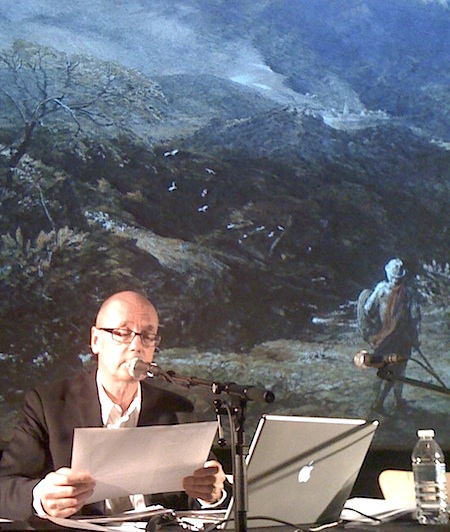
David Toop is the author of a number of valuable and erudite books on music
and sound ( ** ), that you might have read. If you
did not, I think you should. His presentation in Kortrijk orbited around the ideas exposed in his
most recent work, published last year:
Sinister Resonance: The Mediumship of the Listener
The line that provided the presentation's title, or motto ("A ghost travelling a half mile
ahead of its own shape"), can be found in the first chapter of William
Faulkner's Light in August. Lena sits down on the ditchbank. She first hears, then also sees the wagon slowly approaching in the far
distance. Despite the plodding mules, it does not seem to progress.
"It seems to hang suspended in the middle distance forever and forever [...]
So much is this so that in the watching of it the eye loses it as sight and sense drowsily merge and blend [...]. So that at last [...]
the sound of it seems to come slow and terrific and without meaning, as though it were a ghost travelling a half mile ahead of its own shape."
David rightly argues that very often "histories of what we call 'sound art' are rather limiting and narrow": there exists a great corpus of painting and literature that "is a precursor - in the sense of prehistory - of our contemporary discourse around sound and listening".
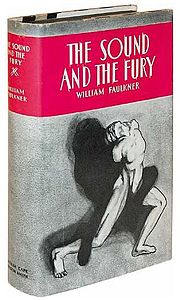 Faulkner's
work for this is a very rich source. His novels, like Joyce's, indeed
have always struck me as being also great works of sound. For me personally
there came a nice moment of recognition, when David read the very
same passage from The
Sound and the Fury, that long ago formed the core of Sense of Water,
a piece that I recorded early 1980,
shortly after having read the book. I had not read anything by Faulkner before. The reason why at that time I bought the book, makes
for a good anecdote: it actually was because I had seen Joy Division's Ian
Curtis wearing a t-shirt that read 'The Sound and the Fury'. I seem
to remember that was at the band's concert at the Amsterdam Paradiso, on January
11th, 1980; but as I have not been able to verify that (on pictures of the
concert, for example), it might just have been on a photograph. Like the
one revealed when you pass your cursor over the book's cover (which could have been taken at the Paradiso, but
I do not know its origin. I found it on the web googling 'Ian Curtis sound and fury').
Faulkner's
work for this is a very rich source. His novels, like Joyce's, indeed
have always struck me as being also great works of sound. For me personally
there came a nice moment of recognition, when David read the very
same passage from The
Sound and the Fury, that long ago formed the core of Sense of Water,
a piece that I recorded early 1980,
shortly after having read the book. I had not read anything by Faulkner before. The reason why at that time I bought the book, makes
for a good anecdote: it actually was because I had seen Joy Division's Ian
Curtis wearing a t-shirt that read 'The Sound and the Fury'. I seem
to remember that was at the band's concert at the Amsterdam Paradiso, on January
11th, 1980; but as I have not been able to verify that (on pictures of the
concert, for example), it might just have been on a photograph. Like the
one revealed when you pass your cursor over the book's cover (which could have been taken at the Paradiso, but
I do not know its origin. I found it on the web googling 'Ian Curtis sound and fury').
I thought that was a great yell to wear on a t-shirt. I wished I had come up with it myself. Only later I found out that it was the title of a novel by William Faulkner. (Who, in turn, got his title from another classic William: you can look it up in Shakespeare's Macbeth - act 5, scene 5: "it is a tale told by an idiot, full of sound and fury, signifying nothing".)
[ added June 26th: I asked the members of the Ultra (1979-1983) Facebook group (dedicated to Ultra, the Dutch brand of early 1980's post-punk experimental pop) whether someone knew more about this particular photo of Ian Curtis. I got an almost immediate and definite answer. Menno Grootveld told me that the t-shirt was made by Dutch artist and graphic designer Zsa Zsa Linnemann, in 1979 (at the time she was still a student, of course). Zsa Zsa was a big admirer of Faulkner's book, and this actually was her very first design. She also knew Ian Curtis personally, who saw the t-shirt and thought it was pretty cool. He then decided to wear it on stage for Joy Division's gig at the Amsterdam Paradiso. Much to the dislike of the other band members, Menno added, who thought it was way too pretentious. The picture was made by Dutch photographer Lex van Rossen (1950-2007). In the meantime I also got to know Zsa Zsa, who proposed to do a re-make of the shirt for me. So in the future you might even catch me wearing one. On very special occasions ;-) ... Thank you Menno, thank you Zsa Zsa! Thanks also to John Oomkes, who confirmed that the picture was taken by Lex van Rossen, on January 11th, 1980, in the Amsterdam Paradiso. ]
...
Earlier that same afternoon at the Kortrijk Budascoop, Dutch sound artist Edwin van der Heide took the stage, to, as he said, "put some very simple concepts in our brains". These should enable us to "create theories for thinking about sound and space". Edwin's lecture went by the title Space in Sound / Sound in Space.
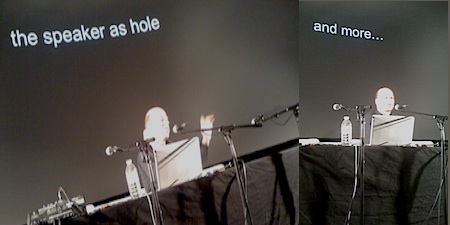
He explained how recordings of sound create virtual spaces in the existing space, introduced a number of useful terms to talk about this (air-borne sounds, structure-borne-sounds, eartones), explained the idea of interference of sounds, and illustrated things by discussing two of his works, which involve and relate to some pretty spectacular architectural work: Waterpavilion and Son-O-House.
...
There should have been another, a third, speaker that afternoon: Bernhard Leitner. Unfortunately though, Bernhard had not been able to make it to Kortrijk. He had fallen ill, and even been taken to the hospital in Paris, just the day before. Instead, Carsten Seiffarth gave a short introduction to Leitner's work, after which Carsten, David and Edwin embarked upon an almost 50 minutes long discussion/debate on the nature of sound art.
I guess that it will come as no surprise that also this long session in the end was far from being conclusive. But some good anecdotes were told, and a number of very general (as well as very fluid) lines of demarcation were sketched.
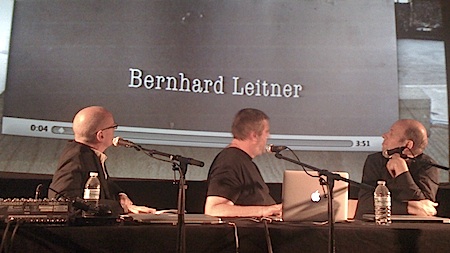
Edwin van der Heide emphasized the idea that the composition of music in the traditional sense takes place within the context of (music) history, but is context-free ('universal'), in the sense that it generally does not take the context (location / space) of its performance into consideration. But of course there are many, old as well as very recent, counter-examples to this. Too many even to try and mention. Edwin then went on to distinguish between 'structural' and 'conceptual' works of sound art.
Carsten Seiffarth stated that for him, personally, thinking about sound art over time has shifted from music to the visual arts, to pieces that are site specific and very close to installation- and sculptural art.
What nowadays is called and presented as 'sound art', lives somewhere in the vast (conceptual) space between music and the visual arts. Disciplines that, as soon as one puts one's mind to it, will appear to be not much less difficult to define and pin down. All categorizations are necessarily fluid. And corrupted. "Partly, it is how history begins to construct a narrative," David Toop said, "and partly it is how people want to see themselves. We find individual artists displaying a kind of perversity, saying: 'No, I don't want to be that; only because you (the media) want me to be it'."
David also pointed to the pragmatism involved. For someone making things with sound, it may make very good sense to stop from categorizing herself as a composer or musician, and to say 'I am an artist', in order to be able to make a move to the economy of the art world.
Someone from the audience then said that to him very often what is presented as 'sound art', is just music; unfortunately, though, it is often not so very good music.
But then could it not be that some 'not so very good' music turns out being 'great art'?
...
Ha, ha! Got you there, now, didn't I?! (Paraphrasing and taking out of its context a Bertolt Brecht line: Wirklich, wir leben in finsteren Zeiten! ... Let me here claim the (tentavive) title for a book, that one day I might sit down to write: ((-- 'Lousy music, great art' --)) ;-)
...
The presentations in Kortrijk were part of the third day of Listen: Perspectives on Auditive Space, a symposium and series of performances organized and curated by Esther Venrooy. Listen had started two days earlier in another Belgium city, that of Ghent. In Ghent there were an exhibition, a day of lectures, and a day of performances. I only caught the closing day in Kortrijk, though.
That closing day of the three-day event, on May 20th, itself ended in the late afternoon, when, in a room somewhere inside the Budascoop, Paul Devens, as part of (a reconstruction) of his 2006 performance/installation Testing Ground - quite literally - brought down the ceiling.
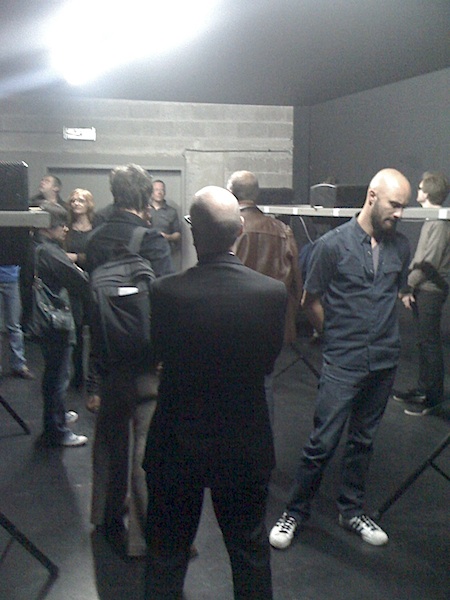 |
||
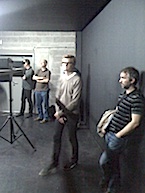 |
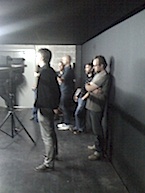 |
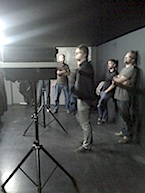 |
...
Tasting ever more brands of Belgium beer (some of them pretty rare), later that night, after dinner, we found ourselves in a private back room of cafe De Dingen, in de Budastraat, which struck me as resembling a possible hide-out for one of the many on-the-run and no (or not very much) longer to be dictators and their ilk, that our time and age know in such abundance.
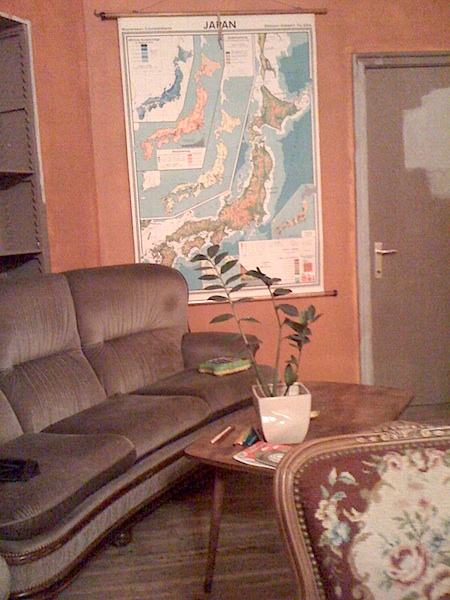
...
Then and there in De Dingen, a back room was the right place to be. For some things are better kept private. Edwin van der Heide strumming and singing along to an untuned guitar doesn't make for great music. And, admittedly, when Paul Devens and myself stuffed our iThings playing sound apps into a couple of empty beer glasses ... well, that didn't make for great sound art either ...
But!
It was fun.
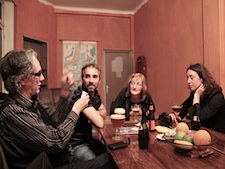 |
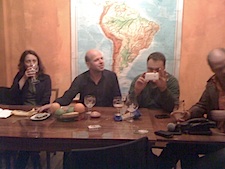 |
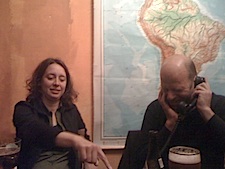 |
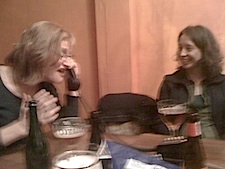 |
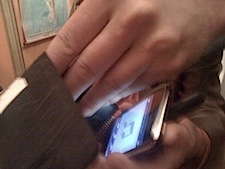 |
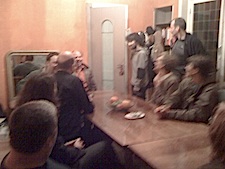 |
...
notes __ ::
(*) To keep yourselves
finely tuned on a near to daily basis to the very heartbeat of our sonic
dynamix, it suffices to follow
twitter.com/soundblog. [
^ ]
(**) Here are Amazon links to three of David's books: Ocean of Sound: aether talk, ambient sound and imaginary worlds (1996) ;
Haunted Weather: Music, Silence and Memory
(2004) ;
Sinister Resonance: The Mediumship of the Listener
(2010).
[
^ ]
tags: Kortrijk, Resonance, sound art, music, Paul Devens, David Toop, Edwin van der Heide, Ian Curtis, Joy Division
# .406.
comments for Listen! (Sound-Art-Music) ::
|
Comments are disabled |